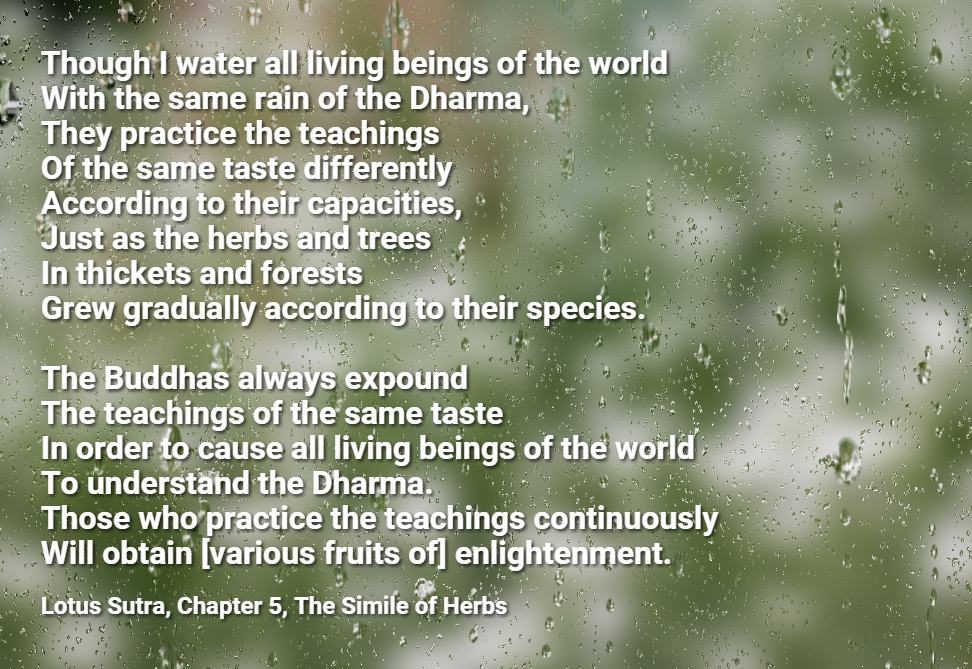Day 3 opens Chapter 2, Expedients.
I want to copy and paste the entire day’s reading here. Instead I continue my meager efforts to distill what I’ve read.
The wisdom of the [present] Buddhas is profound and immeasurable. The gate to it is difficult to understand and difficult to enter. [Their wisdom] cannot be understood by any Śrāvaka or Pratyekabuddha because the [present] Buddhas attended on many hundreds of thousands of billions of [past] Buddhas, and practiced the innumerable teachings of those Buddhas bravely and strenuously to their far-flung fame until they attained the profound Dharma which you have never heard before, [and became Buddhas,] and also because [since they became Buddhas] they have been expounding the Dharma according to the capacities of all living beings in such various ways that the true purpose of their [various] teachings is difficult to understand.
I do hear the Buddha’s voice:
The Tathāgatas divide [the Dharma] into various teachings, and expound those teachings to all living beings so skillfully and with such gentle voices that living beings are delighted.
It is delightful. No purely intellectual study can fathom this; only faith can reveal it:
The Dharma cannot be shown.
It is inexplicable by words.
No one can understand it
Except the Buddhas
And the Bodhisattvas
Who are strong in the power of faith.
Hence Śāriputra’s confusion:
“World-Honored One! Why do you extol so enthusiastically [what you call] the highest [Truth, and the power of the Buddhas to employ] expedients? [Why do you extol] the Dharma which [you say] is profound, wonderful, and difficult to understand? I have never heard you say all this before. The four kinds of devotees also have the same doubts. World-Honored One! Explain all this! Why do you extol so enthusiastically the Dharma which [you say] is profound, wonderful, and difficult to understand?”
It takes three requests by Śāriputra to demonstrate enough enthusiasm to overcome the Buddha’s concern:
“No. If I do, all the gods, men and asuras in the world will be frightened and perplexed, and arrogant bhikṣus will fall into a great pit.”
And when he finally agrees to expound the Dharma 5,000 among the four types of believers – bhikṣus, bhikṣuṇīs, upāsakas, and upāsikās – up and left.
Thereupon the World-Honored One said to Śāriputra: “Now this congregation has been cleared of twigs and leaves, only sincere people being left. Śāriputra! Those arrogant people may go. Now listen to me attentively! I will expound [the Dharma] to you.”
It is because the Dharma cannot be understood by reasoning that “various teachings with innumerable expedients” are used. But there is still only goal:
“Śāriputra! What is the one great purpose for which the Buddhas, the World-Honored Ones, appear in the worlds? The Buddhas, the World-Honored Ones, appear in the worlds in order to cause all living beings to open [the gate to] the insight of the Buddha, and to cause them to purify themselves. They appear in the worlds in order to show the insight of the Buddha to all living beings. They appear in the worlds in order to cause all living beings to obtain the insight of the Buddha. They appear in the worlds in order to cause all living beings to enter the Way to the insight of the Buddha. Śāriputra! This is the one great purpose for which the Buddhas appear in the worlds.”
Don’t confuse the expedients necessary to reach people of various capacities with the Dharma:
“Śāriputra! I also expound various teachings to all living beings only for the purpose of revealing the One Buddha-Vehicle. There is no other vehicle, not a second or a third.”
And again:
“Śāriputra! All the Buddhas in the past expounded various teachings to all living beings with innumerable expedients, that is to say, with stories of previous lives, parables, similes and discourses, only for the purpose of revealing the One Buddha-Vehicle. The living beings who heard those teachings from those Buddhas finally obtained the knowledge of the equality and differences of all things.”
Buddhas in the future will do the same just as they do in the present.
“Śāriputra! So do I. I know that all living beings have various desires. I also know that they have attachments deep in their minds. Therefore, I expound various teachings to them with stories of previous lives, parables, similes and discourses, that is to say, with various expedients according to their natures.
“Śāriputra! I do all this for the purpose of causing them to realize the teaching of the One Buddha-Vehicle, that is, to obtain the knowledge of the equality and differences of all things. Śāriputra! There is not a second vehicle in the worlds of the ten quarters. How can there be a third?”
This can’t be rationalized and intellectually examined:
“Śāriputra and all of you present here! Understand the Dharma by faith with all your hearts! There is no vehicle other than the One Buddha-Vehicle.”

